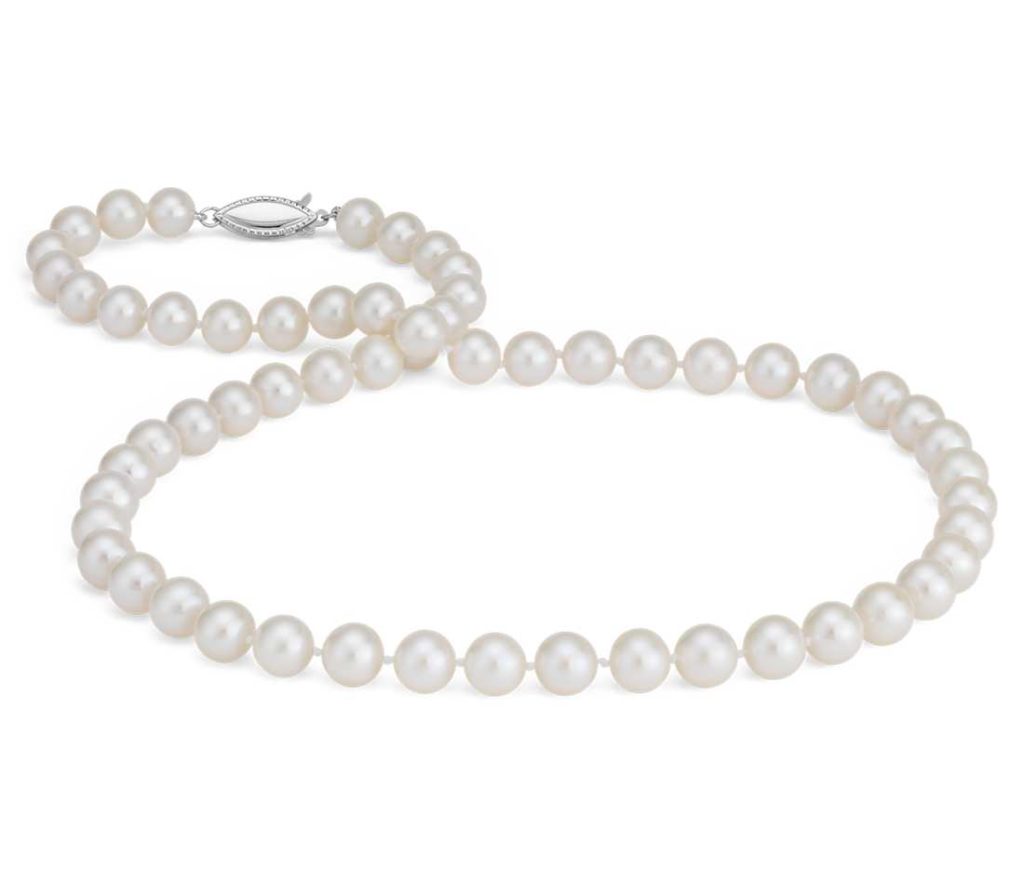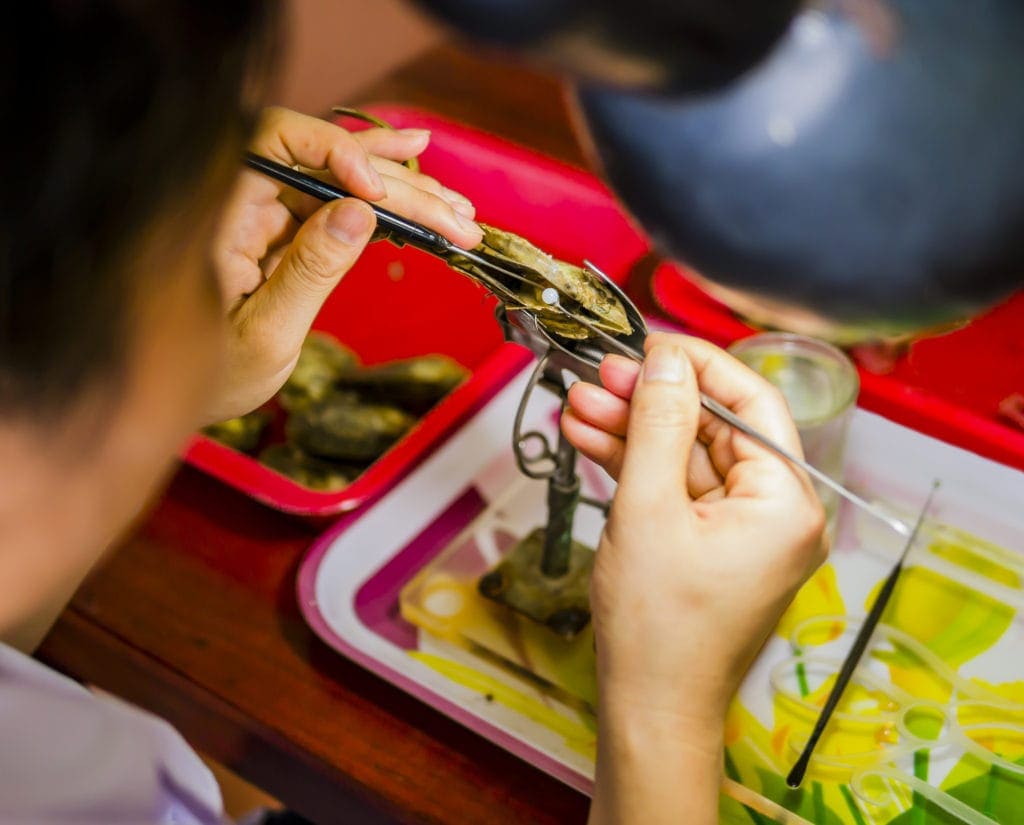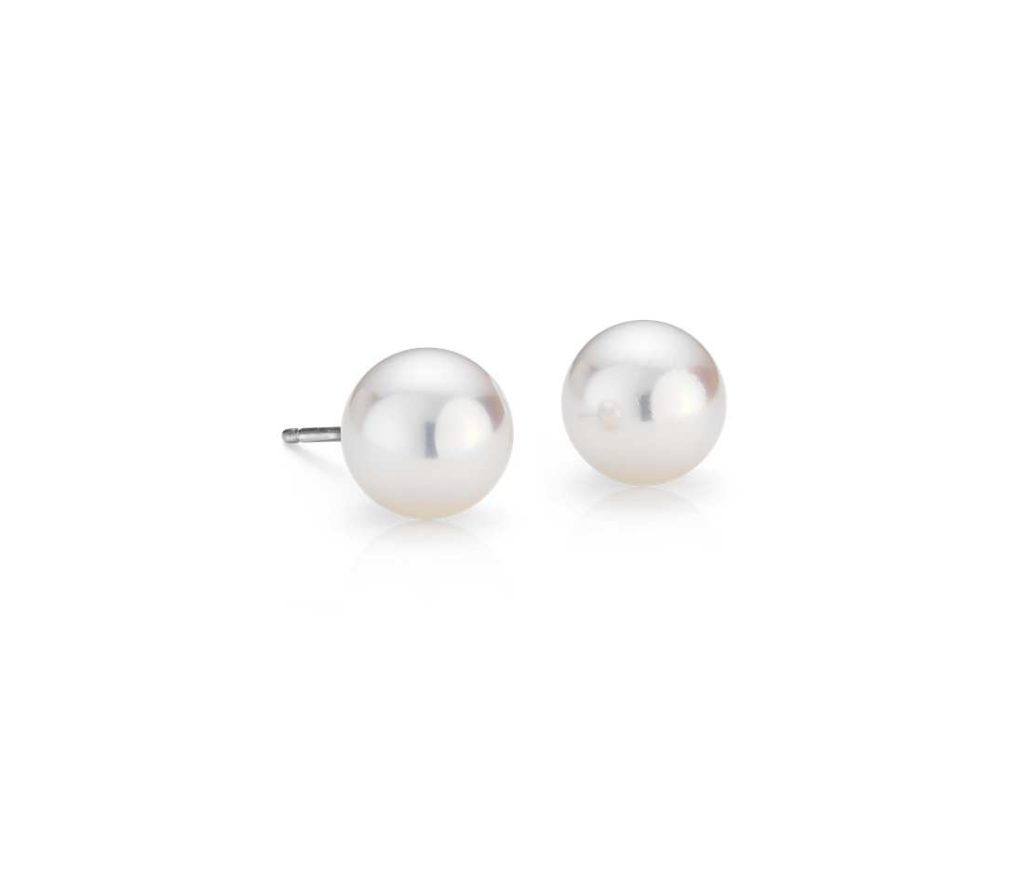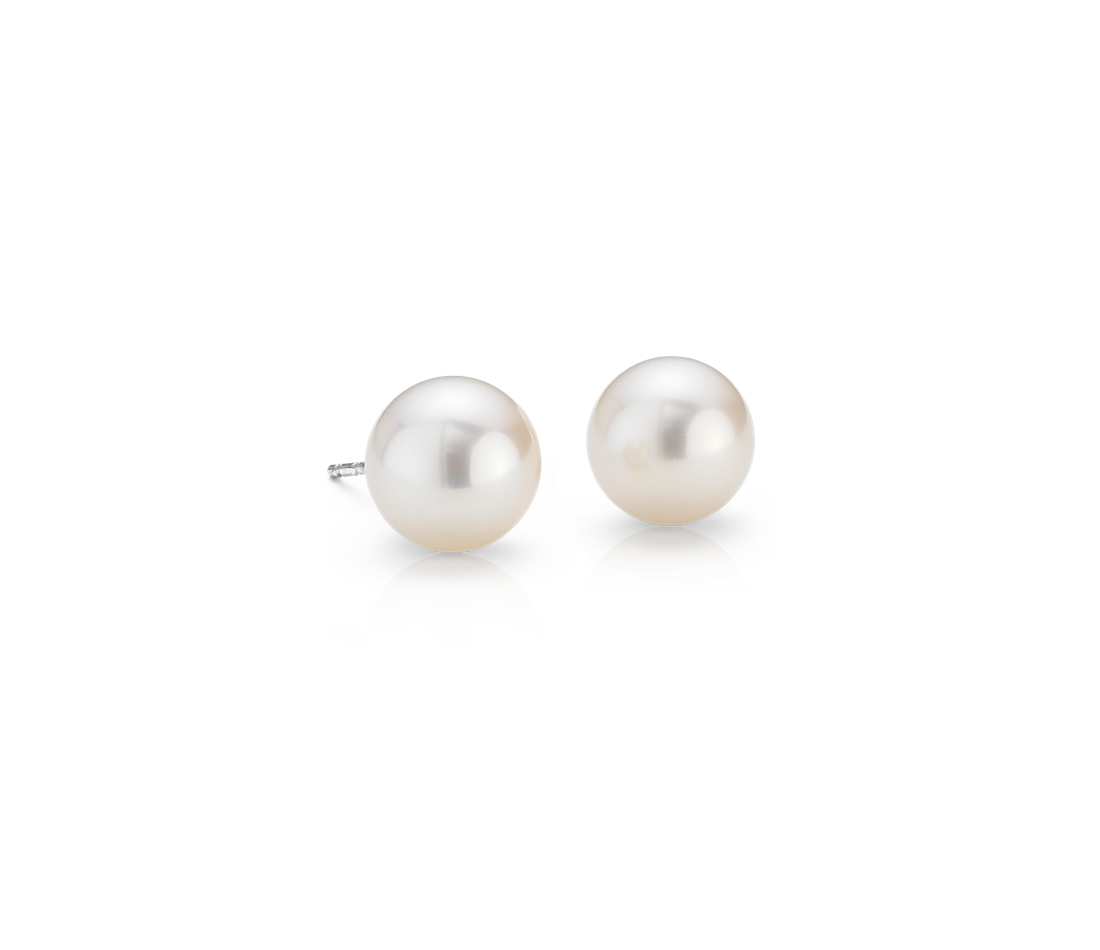Freshwater pearls are typically called the ‘fashion forward’ pearl because of their stunning range of colors, sizes, shapes and overtones. No other pearl variety has as much diversity. This makes freshwater pearls a favorite among designers, as they can utilize the pearls in a range of ways, from avant-garde designs to more traditional strands.
Because of their lower price, they’re perfect for every shopper, offering something different to everyone.
Here’s a buying guide for freshwater pearls, the most common and perhaps best-loved pearl variety on the market.
Freshwater Pearl Jewelry
The most classic way to wear pearl jewelry is in necklace and bracelet strands as well as in studs and dangles. Pair them with diamonds for a sophisticated, royal look suitable for the red carpet.

Classic freshwater pearl strand necklace from Blue Nile.
While perfectly round pearls are always the most in demand, these days, baroque shapes have taken the fashion world by storm. The unique shapes of freshwater pearls are inspiration for fancy, modern designs that are highly sought-after.
Because freshwater pearl jewelry is affordable, they’re perfect for a pearl beginner or someone who loves wearing pearls but doesn’t want to dish out huge sums of money for them. These are the most affordable pearls, but perfectly round stones are very hard to come by and can be more expensive. Also, note that the brand name and other materials used in the jewelry can significantly add to the overall price of the piece.
Why Choose Freshwater Pearls Vs. Other Types Of Pearls?
There are several reasons why you might decide to choose freshwater pearl pearls and jewelry made with them over Akoya or other types of pearls:
- You are on a budget. There’s nothing wrong with wanting to spend a little less on a piece of jewelry, especially if the budget-friendly option is as pleasing to the eye as the more expensive ones.
- The pearl jewelry you’re buying is to be worn regularly and not just on special occasions. The thick nacre layers of freshwater pearls are a huge plus in terms of durability. Where Akoya pearls last decades because they are rarely worn, freshwater pearls can last just as long while being worn much more often.
- You don’t mind the slight variations in the pearl shape of freshwater pearl jewelry. This too is an easy condition to meet considering that the different shapes of freshwater pearls can be viewed as a positive as well – they make the jewelry pieces more diverse and unique, and the more oval shapes work really well for earrings. Of course, you can also find perfectly round freshwater pearls.
As you can see, while freshwater pearls are not typically as highly regarded as their saltwater Akoya relatives, there are good reasons why they are the one of the most popular pearl types.
Where Do Freshwater Pearls Come From?
Freshwater pearls come from mollusks cultivated in, you guessed it, freshwater sources. However, like most things today, these are also made in China.
Most freshwater pearls come from China with some farms in Japan and the US as well. In the U.S. there is some limited farming in the Mississippi River basin while Japan still has some Biwa pearls and Lake Kasumigaura pearls but those are practically inconsequential from a commercial point of view.
Instead, China is the market that produces the vast majority of commercial freshwater pearls in the world, from either the Hyriopsis cumingi (triangle shell) or Hyriopsis schlegeli (Biwa shell) mussels. According to the Gems and Jewelry Trade Association of China, the Asian country has been producing between 1,000 and 2,000 tons of freshwater pearls per year since the 1990s and the early 2000s. That’s in addition to the approximately 20 tons of marine cultured Akoya pearls they also produce.
China has been a giant in the freshwater pearl industry ever since the 1980s, but they became the dominating power they are today in the 1990s when they ramped up production even more.
And no wonder. The Chinese have a long tradition of pearl farming – Chinese fishermen from the Hepu and Behai regions have been farming saltwater pearls ever since the Han dynasty in the 3rd century AD.
Cultivating Freshwater Pearls
What exactly are freshwater pearls? While we all know that oysters create pearls, freshwater pearls come, not from oysters, but from mussels instead.
In China, pearl mussels are typically cultivated in abandoned and large rice paddies that have been excavated and artificially flooded. They are usually 2 to 3 meters/feet deep and they are easily harvested. Each mussel is surgically implanted with 24 to 32 small pieces of mantle tissue that grow into 24 to 32 pearls in the span 6 months to 2 years.
This process is called nucleation as each of these mantle tissue pieces turns into the nucleus of a future pearl. Over several months, the mussel slowly secretes nacre over the nucleus, forming multiple layers of nacre around it.
Freshwater pearls have a small or non-existent nucleus which means that they’re made almost entirely of nacre. In comparison, Akoya pearls contain a bead nucleus meaning that the actual layer of nacre is much thinner. The solid nacre of freshwater pearls gives them better durability and a beautiful appearance.
Freshwater Pearls Vs. Cultured Pearls

Extracting freshwater pearls.
A lot of people get confused when researching the difference between freshwater pearls and cultured pearls since both terms are often used for freshwater pearls. For example, the U.S. Federal Trade Commission requires that all commercial freshwater pearls are referred to as “freshwater cultured pearls”. In principle, cultured pearls are all pearls that are farmed and not just fished from wild mussels or oysters. Almost all freshwater and saltwater pearls sold today are cultured pearls.
Freshwater pearls, on the other hand, are simply pearls farmed from freshwater mussels. In the past, freshwater pearls were also fished from wild mussels such as the Holarctic freshwater pearl mussel in Scotland but today they are endangered in most countries and are not fished for commercial purposes. This means that all freshwater pearls on the market come from cultured sources.
Freshwater Pearls Vs. Akoya Pearls
Akoya are the most popular saltwater pearls sold today and when looking for pearl jewelry to purchase, they will be the main alternative to freshwater pearls you’ll come across.
In terms of their physical characteristics, Akoya pearls have a significantly larger nucleus and thinner nacre layers. This gives them a typically whiter color and a very high pearl luster. They are also much rounder than most freshwater pearls because they contain a bead nucleus, which gives the oyster the ‘template’ to create a perfect pearl.

Akoya pearls have higher luster.
Another significant difference between these two pearl varieties is that when Akoya farmers implant the nucleus in the oyster, they insert a single perfectly round bead nucleus instead of the 24 to 32 tissue strips inserted into freshwater mussels. As a result, freshwater pearls are more abundant than Akoya pearls. Both the relative rarity and quality of Akoya pearls naturally translate into a higher price as well. For those reasons, Akoya pearls are the more luxurious alternative to freshwater pearls.
However, as freshwater farming practices continue to evolve and improve, it’s getting harder and harder to distinguish between freshwater and saltwater pearls. The luster, shape and other characteristics are continually improving, making these pearls an excellent choice for stunning pearls at a lower price.
Freshwater Pearls Meaning
Freshwater pearls are typically associated with the purification of inner-body energies. Jewelry and amulets of freshwater pearls are meant to be worn when you need to cleanse the negative energy you might have accumulated inside of you. They are believed to be a good way to reset your stressful feelings and thoughts and to redirect your focus in more productive directions.
Some believe that a freshwater pearl can keep you from failing, helping you to see your decisions through without regret. It’s also viewed as a way to heal past sorrows and ward of evil spirits and negative energies.
While we can’t guarantee that these claims are true, it adds an extra layer of symbolism for those who like meaningful jewelry.






